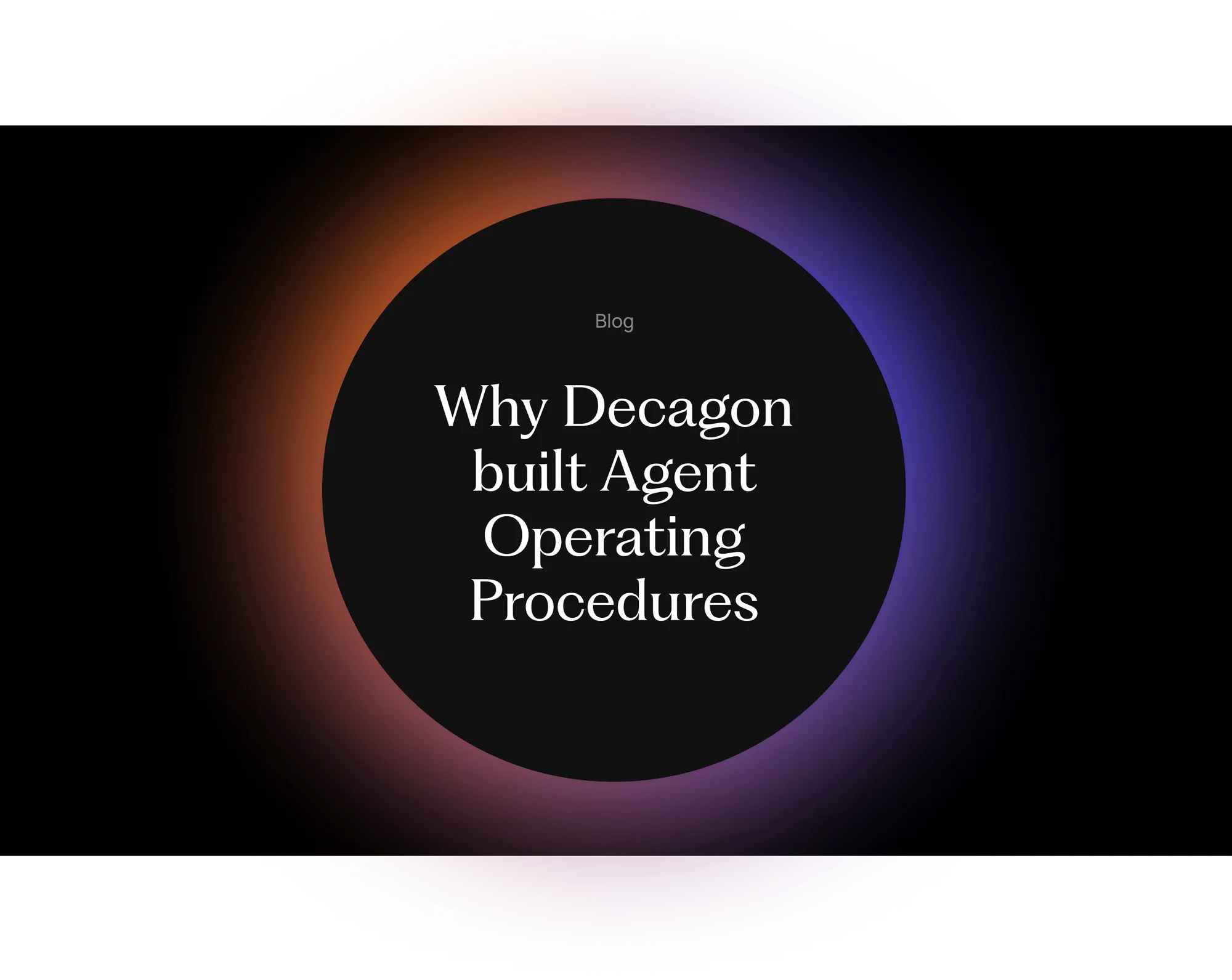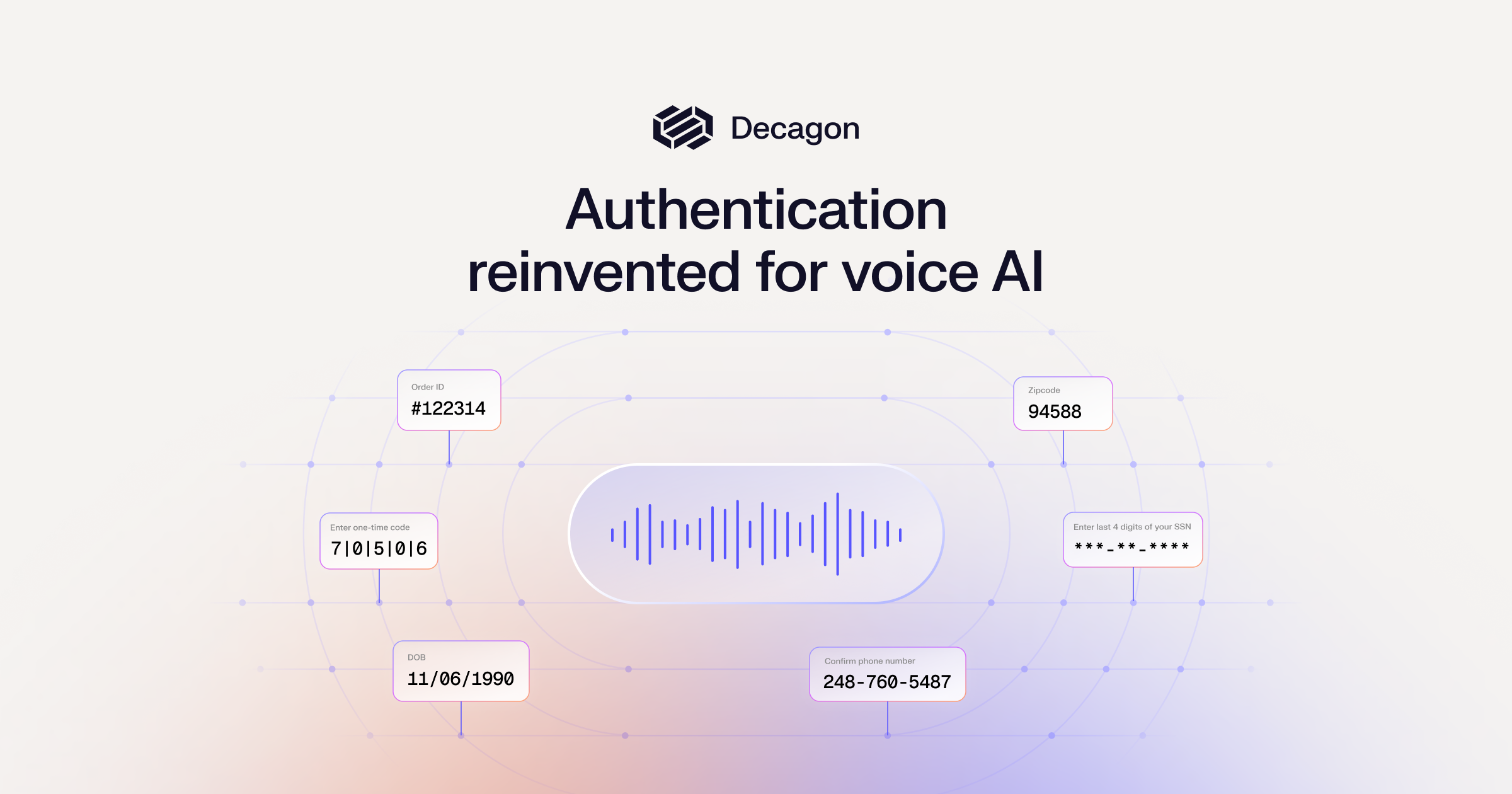Why Decagon built Agent Operating Procedures

Businesses can no longer rely on the rigidity of legacy systems to meet the dynamic demands of customer service. Historically, organizations built extensive decision trees in an attempt to encode any potential response or prompt from a customer. It didn’t take long before they discovered that these brittle structures often collapse when confronted with the vague, imperfect prompts given to them in the real-world.
To meet and exceed expectations when it comes to customer experience, AI will have to learn from those that came before it. Human agents have long relied on Standard Operating Procedures (SOPs) to ensure consistency, accuracy, and efficiency. As businesses shift to AI-powered customer experience, AI will require a similar framework.
At Decagon, we built Agent Operating Procedures (AOPs)—a dynamic, conversational approach that mirrors the adaptability of human agents while leveraging the power of generative AI.
Breaking free from legacy decision trees
Traditional decision trees are inherently linear and static. They were designed for scenarios where user interactions followed a predictable, “happy path.” However, in practice, customer queries rarely adhere to these neat, predefined routes. The result is an enormous, unwieldy network of branches that require constant maintenance and updates. AOPs solve this problem by offering a natural language framework that is both fluid and scalable. Rather than codifying every possible scenario into an inflexible tree structure, AOPs allow you to articulate your business logic in a way that the AI can interpret and adapt to diverse situations.
The core design principles
Decagon’s AOPs are built on three key principles that empower organizations to innovate faster without compromising on safety:
- Speed to Build: AOPs are designed for rapid iteration. Business users can shape the behavior of the AI agent using natural language, while technical teams can develop underlying integrations in parallel. This dual approach minimizes bottlenecks, enabling swift rollout of updates and new features.
- Flexibility: By merging conversational instructions with code-based logic, AOPs adapt to the unpredictable nature of customer interactions. This flexibility not only enhances the user experience but also ensures that customer experience workflows are scalable and resilient, avoiding the pitfalls of rigid, pre-programmed paths.
- Guardrails: While adaptability is essential, maintaining strict controls for critical operations is equally important. AOPs incorporate built-in safeguards—executing key validation steps in code—to ensure that sensitive actions, such as processing refunds or verifying customer identities, are handled securely.
Future-proofing your support infrastructure
Decagon’s AOPs are more than a technical innovation—they represent a shift towards a future-proofed customer experience ecosystem. By combining the speed of natural language development with the robustness of code-based validation, organizations can:
Adapt quickly: Rapid iteration means that new features, policy updates, and emerging customer needs can be addressed in real time.
Reduce costs: Streamlined development processes and parallel collaboration between business and technical teams lower the overhead associated with traditional, maintenance-heavy systems.
Enhance customer experience: Dynamic, context-aware interactions ensure that every customer touchpoint is handled with precision and empathy, leading to higher satisfaction and loyalty.
Stay ahead of the curve: As the landscape of AI continues to evolve, Decagon’s AOPs provide a scalable, resilient foundation that grows with your business, ensuring that your customer experience infrastructure remains agile in the face of change.
Decagon’s Agent Operating Procedures are redefining what it means to deliver intelligent, adaptable customer experience. By moving away from brittle decision trees and embracing a natural language framework reinforced with robust guardrails, AOPs empower organizations to build AI agents that are both agile and reliable. This blend of speed, flexibility, and safety not only accelerates innovation but also positions businesses to thrive in a rapidly changing digital world. We’d love to show you how.
Why Decagon built Agent Operating Procedures
April 9, 2025

Businesses can no longer rely on the rigidity of legacy systems to meet the dynamic demands of customer service. Historically, organizations built extensive decision trees in an attempt to encode any potential response or prompt from a customer. It didn’t take long before they discovered that these brittle structures often collapse when confronted with the vague, imperfect prompts given to them in the real-world.
To meet and exceed expectations when it comes to customer experience, AI will have to learn from those that came before it. Human agents have long relied on Standard Operating Procedures (SOPs) to ensure consistency, accuracy, and efficiency. As businesses shift to AI-powered customer experience, AI will require a similar framework.
At Decagon, we built Agent Operating Procedures (AOPs)—a dynamic, conversational approach that mirrors the adaptability of human agents while leveraging the power of generative AI.
Breaking free from legacy decision trees
Traditional decision trees are inherently linear and static. They were designed for scenarios where user interactions followed a predictable, “happy path.” However, in practice, customer queries rarely adhere to these neat, predefined routes. The result is an enormous, unwieldy network of branches that require constant maintenance and updates. AOPs solve this problem by offering a natural language framework that is both fluid and scalable. Rather than codifying every possible scenario into an inflexible tree structure, AOPs allow you to articulate your business logic in a way that the AI can interpret and adapt to diverse situations.
The core design principles
Decagon’s AOPs are built on three key principles that empower organizations to innovate faster without compromising on safety:
- Speed to Build: AOPs are designed for rapid iteration. Business users can shape the behavior of the AI agent using natural language, while technical teams can develop underlying integrations in parallel. This dual approach minimizes bottlenecks, enabling swift rollout of updates and new features.
- Flexibility: By merging conversational instructions with code-based logic, AOPs adapt to the unpredictable nature of customer interactions. This flexibility not only enhances the user experience but also ensures that customer experience workflows are scalable and resilient, avoiding the pitfalls of rigid, pre-programmed paths.
- Guardrails: While adaptability is essential, maintaining strict controls for critical operations is equally important. AOPs incorporate built-in safeguards—executing key validation steps in code—to ensure that sensitive actions, such as processing refunds or verifying customer identities, are handled securely.
Future-proofing your support infrastructure
Decagon’s AOPs are more than a technical innovation—they represent a shift towards a future-proofed customer experience ecosystem. By combining the speed of natural language development with the robustness of code-based validation, organizations can:
Adapt quickly: Rapid iteration means that new features, policy updates, and emerging customer needs can be addressed in real time.
Reduce costs: Streamlined development processes and parallel collaboration between business and technical teams lower the overhead associated with traditional, maintenance-heavy systems.
Enhance customer experience: Dynamic, context-aware interactions ensure that every customer touchpoint is handled with precision and empathy, leading to higher satisfaction and loyalty.
Stay ahead of the curve: As the landscape of AI continues to evolve, Decagon’s AOPs provide a scalable, resilient foundation that grows with your business, ensuring that your customer experience infrastructure remains agile in the face of change.
Decagon’s Agent Operating Procedures are redefining what it means to deliver intelligent, adaptable customer experience. By moving away from brittle decision trees and embracing a natural language framework reinforced with robust guardrails, AOPs empower organizations to build AI agents that are both agile and reliable. This blend of speed, flexibility, and safety not only accelerates innovation but also positions businesses to thrive in a rapidly changing digital world. We’d love to show you how.





